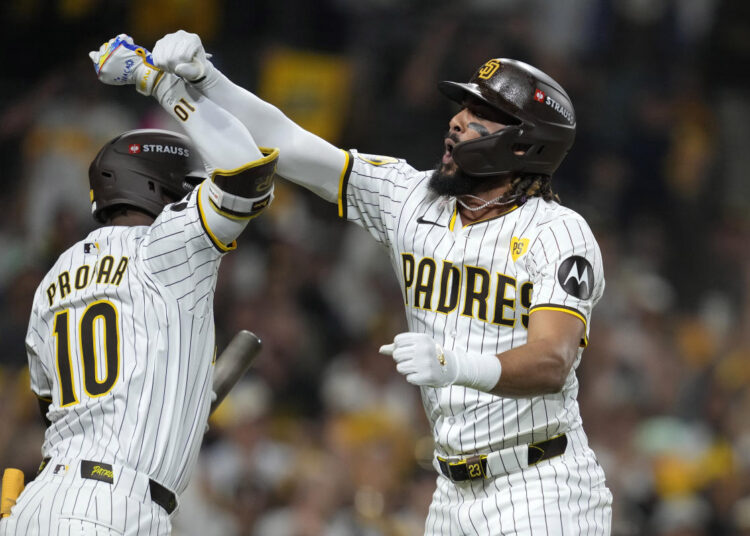SAN DIEGO — There was a lot of noise between Game 2 and Game 3 of the NLDS. The Dodgers felt disrespected after some verbal jousting and a much-analyzed toss by Manny Machado. The Padres felt disrespected after Fernando Tatis Jr. was drilled by Jack Flaherty, leading to a whole lot of chirping.
There is no love lost between these two teams. That energy and intensity created plenty of tension leading into Game 3, tension that permeated a packed Petco Park on Tuesday. Before the first pitch, you could feel the building shaking in anticipation.
But the Padres aren’t scared of the Dodgers. They aren’t scared of Los Angeles’ vaunted lineup, and as they showed in Game 2, they aren’t scared of Dodger Stadium, either. They know they can beat the Dodgers in October because they’ve done it before. And once the series got back on San Diego soil, the Padres were ready to let their play talk for them.
“Definitely no fear,” Fernando Tatis Jr. said of his team’s mentality. “But that’s something that you build through the years, getting experience playing against those guys.”
For a microcosm of who this Padres team is, look no further than the second inning of Game 3, in which they put the Dodgers on the brink of another early October elimination with a 6-5 victory.
After losing Game 2 by a score of 10-2, L.A. needed to strike first on Tuesday — and did, finally getting a lift from Mookie Betts, who snapped an 0-for-22 postseason hitless streak with a solo home run that gave the Dodgers a 1-0 lead in the first inning.
But San Diego’s lineup was relentless in the second against Dodgers starter Walker Buehler — and the Dodgers’ defense. Manny Machado started the inning with a single. Jackson Merrill followed with a ground ball to Freddie Freeman that the first baseman would normally turn into at least a force out, maybe even a double play. But this was not the Dodgers’ night.
The former Gold Glove Award winner instead threw the ball into left field, allowing Machado to get to third, putting Merrill on first and setting the table for a monster inning for San Diego. Giving a team extra outs is never the recipe for success, and for a team with as much momentum as these Padres, that was just the sliver of room they needed to change the game and take control of the series.
Things got worse for L.A. on the next play, as a slow chopper hit by Xander Bogaerts was fielded by Miguel Rojas, but he was unable to get a single out, with Merrill beating the feed to second and Bogaerts beating the throw to first. Machado trotted home to score the Padres’ first run before an out had been recorded in the inning.
The next batter, David Peralta, made L.A. pay for the defensive miscues, roping a two-run double down the right-field line and unleashing a sellout Petco Park crowd.
“We’re good, man,” Peralta, a 37-year-old veteran who signed a minor-league contract with San Diego in May, said afterward. “The first day that I stepped into the clubhouse … they just welcomed me. It’s just a great group of guys, you know. We’re all together. It’s like a brotherhood.”
What felt like a celebration for San Diego was quickly becoming a disaster for Los Angeles.
“There were just balls that we just didn’t convert into outs,” Dodgers manager Dave Roberts said postgame. “And it builds the stress in the inning.”
The Padres continued their onslaught following Peralta’s double, adding a run on a Kyle Higashioka sacrifice fly after a Jake Cronenworth single. Then the Dodgers’ failure to turn batted balls into outs, particularly against the bottom of the Padres’ order, meant the lineup turned over, bringing to the plate one man who doesn’t disappoint this time of year.
As he has been doing all postseason, Tatis brought the city of San Diego to its feet with one swing. And when he launched a no-doubt, two-run blast off the facing of the second deck, giving San Diego a 6-1 lead, one thing was clear: This Padres team will not be denied.
“I just blacked out,” Tatis said later. “I feed off that type of energy. When the fans are coming, [you have] meaningful games, you leave everything that you have out there. I just feel like I just take it to another level — my mindset, my body, just everything is just through the roof.”
Tatis’ homer continued his dominance against the Dodgers — .264/.326/.544 with 19 home runs in his career — and in the postseason. He now carries an eye-popping 1.969 OPS this October, with a .556 average and four homers, three of them in this series.
Not even a Dodgers rally the following inning could stop the runaway train that is the Padres. A grand slam from Teoscar Hernandez after three consecutive singles opened the door for a comeback, but San Diego’s bullpen slammed it shut. Padres starter Michael King made it through five innings of work, and then the electric quartet of Jeremiah Estrada, Jason Adam, Tanner Scott and Robert Suarez combined for four scoreless innings, surrendering just one hit as they sealed the home team’s victory and set up a potential series-clinching Game 4 on Wednesday.
But let’s be clear: Saying that all the chatter before Game 3 ignited this Padres team would miss the fact that they didn’t actually need a push. San Diego had the best record in baseball after the All-Star break, and after sweeping the Braves in the wild-card round and taking a firm hold of this NLDS, with a chance to send the Dodgers home, they look like the best team in baseball.
When you compare the Dodgers and Padres, the key difference is not the caliber of the players or the environment in the ballpark; it’s the mentality in the clubhouse. From Game 1, the Dodgers have had all the pressure on them. Their win in the first contest of this series felt more like a sigh of relief than a victory.
San Diego, on the other hand, has been playing carefree in these playoffs, seemingly with no regard for tomorrow. The Padres play each game like it could be their last, and that’s why they’re the most dangerous team remaining in the field.
“I really just appreciate this group, the way they compete, the way they carry themselves,” manager Mike Shildt said. “Proud of this group. Love them.”
Read the full article here


























